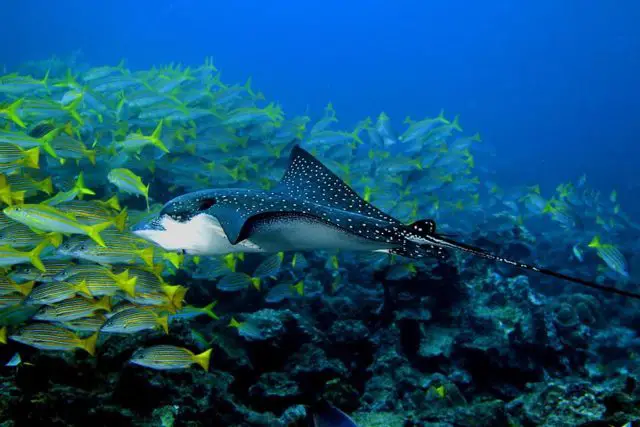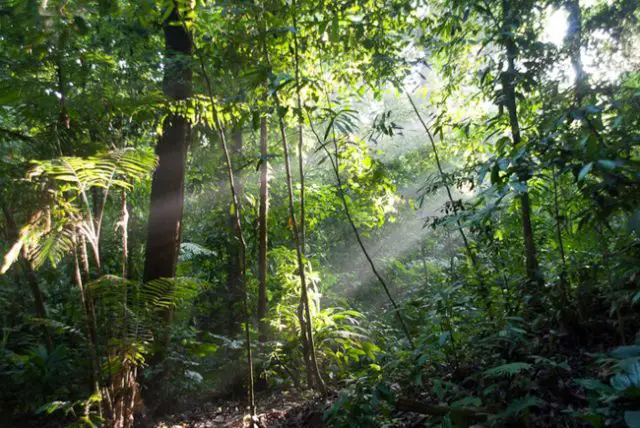The biological reserve Isla del Caño is located far from the Pacific Coast mainland of Costa Rica 16 kilometers from the Osa Peninsula, Puntarenas.
The island covers 320 terrestrial and 5,800 marine hectares. Its waters have one of the most extensive and best-preserved coral reef formations of Costa Rica. There are 5 coral reefs (or low reefs) with extensions ranging from 0.8 to 4.2 hectares. It is an important raising area for humpback whales and their offspring’s, both in the northern and southern hemispheres, as well as resident species of dolphins.
It was declared as a national park and protected area, with a permanent ranger station on the island. It is a popular tourist destination, which attracts visitors for its beaches, coral reefs and marine life.

Researchers are currently using coral beds to study the factors surrounding coral death and the recolonization process. Marine life includes manta rays, sea turtles, whales, dolphins, and a wide variety of fish.
The limited diversity of terrestrial fauna, however, is remarkable, since the island has less than 1% of the peninsula’s diversity of insects and highlights the absence of numerous native animals from the nearby mainland. The evidence of human pre-Columbian activity on the island is substantial, with some interesting artifacts such as the carved stone spheres, made by the first civilizations that inhabited these territories.
Here rivers of clear and pristine waters, which sometimes form spectacular waterfalls, run through the forest and mangroves to the open sea, forming a landscape of Edenic beauty that combines immaculate beaches and the exuberance of the rainforest, which reminds us of the Amazon jungle or Indonesia, with specimens of the Ceiba tree that reach 800 meters.
Biologists estimate that the area hosts some 10,000 species of insects, at least 2,418 species of plants, 700 species of trees, 140 species of mammals (including large predators such as jaguar and puma), 367 species of birds, 117 species of amphibians and reptiles, and 40 species of freshwater fish.
The island is covered by an evergreen tropical rainforest, with approximately 158 species of higher plants and ferns. There are trees up to 50 meters high where thick empty trees protrude, also called the milk tree because of the white latex that exudes and can be drunk. Other species of trees characteristic of this place are the guapinol, the higuerón, the wild cacao, the rubber, and the guarumo, where there are grow epiphytes plants like the bromeliads and orchids.

Also on the island, you can see ferns, Araceae, heliconias, vines, herbaceous plants and some introduced species such as mango, cashew, oranges, guava, and bananas.
The fauna present on the island is scarce. The birds are represented by some 10 species, the most common being the heron of the cattle, the crab-eating sparrowhawk, the eagle fish, and the piquero rosemary. With regard to mammals, four-eyed foxes, tepezcuinte, some rat species, and several bat species have been observed. In addition, small snakes, boas, frogs, and lizards.
It is important to mention that the island was used by the pre-Columbian inhabitants as a cemetery and sacred place, where you can see a clear South American influence like, for example, the perfectly round spheres, made by the natives of these lands.
The biggest attraction on the island is below it, this natural formation considered a new and different place to explore, has walls from 15 and 16 feet up to 80 feet deep. The volcanic rock formations provide the basis for the coral colonies, which in turn give a home to small mollusks, crustaceans and an incredible variety of fish, but due to its biological reserve status, diving in this area is regulated. Likewise, only 10 drivers are allowed in a maximum of 5 sites open to the public.
The importance of this exuberant reserve comes from the archaeological point of view because in pre-Columbian times it was used as an indigenous cemetery. The cultural materials are ceramic remains and carved lithic artifacts. The presence of ceramic remains of the aforementioned Guanacaste middle period suggests that the island was a key point of commercial exchange along the Pacific coast. Also to protect species of flora and fauna characteristic of the tropical rainforest and important marine environments.

